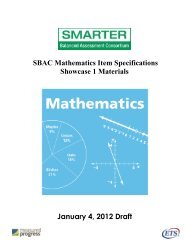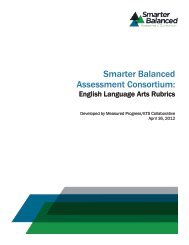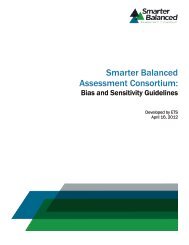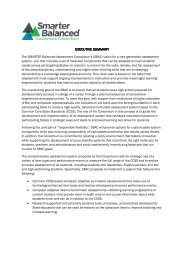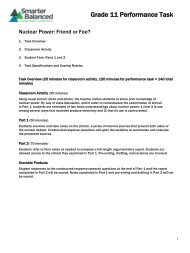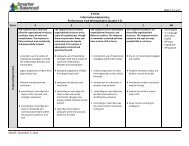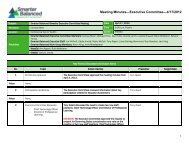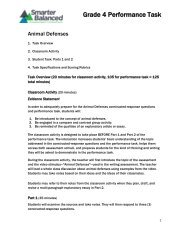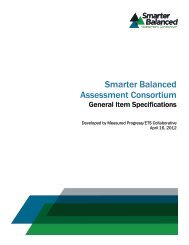Content Specifications for the Summative Assessment of the ...
Content Specifications for the Summative Assessment of the ...
Content Specifications for the Summative Assessment of the ...
Create successful ePaper yourself
Turn your PDF publications into a flip-book with our unique Google optimized e-Paper software.
(DOK 3)<br />
works <strong>of</strong> public advocacy (e.g., The Federalist, presidential addresses).<br />
RH-8 Evaluate an author’s premises, claims, and evidence by corroborating or challenging <strong>the</strong>m<br />
with o<strong>the</strong>r in<strong>for</strong>mation.<br />
RST-8 Evaluate <strong>the</strong> hypo<strong>the</strong>ses, data, analysis, and conclusions in a science or technical text,<br />
verifying <strong>the</strong> data when possible and corroborating or challenging conclusions with o<strong>the</strong>r sources <strong>of</strong><br />
in<strong>for</strong>mation.<br />
Use <strong>the</strong> specific text (or two or more texts) to determine two additional assessment targets (#12, #13, or #14)<br />
to be assessed in relation to <strong>the</strong> text(s).<br />
12. ANALYSIS WITHIN OR ACROSS RI-3 Analyze a complex set <strong>of</strong> ideas or sequence <strong>of</strong> events and explain how specific<br />
TEXTS: Analyze texts to determine how individuals, ideas, or events interact and develop over <strong>the</strong> course <strong>of</strong> <strong>the</strong> text.<br />
connections are made in development <strong>of</strong> RI-9 Analyze documents <strong>of</strong> historical and literary significance <strong>for</strong> <strong>the</strong>ir <strong>the</strong>mes,<br />
complex ideas or events; or in development <strong>of</strong> purposes, and rhetorical features.<br />
topics, <strong>the</strong>mes, rhetorical features<br />
Standards: RI-3, RI-9<br />
(DOK 3)<br />
13. TEXT STRUCTURES/ FEATURES:<br />
Relate knowledge <strong>of</strong> text structures or <strong>for</strong>mats,<br />
or genre features (e.g., graphic/visual<br />
in<strong>for</strong>mation) to integrate in<strong>for</strong>mation or<br />
analyze <strong>the</strong> impact on meaning or presentation<br />
Standards: RI-5, RH-5, RST-5, RI-7, RH-7,<br />
RST-7<br />
(DOK 3, DOK 4)<br />
14. LANGUAGE USE: Analyze <strong>the</strong><br />
figurative (e.g., euphemism, oxymoron,<br />
hyperbole, paradox) or connotative meanings<br />
<strong>of</strong> words and phrases used in context and <strong>the</strong><br />
impact <strong>of</strong> <strong>the</strong>se word choices on meaning and<br />
tone<br />
Standards: RI-4; RH-4; L-5a (gr 9-10), L-5a<br />
(gr 11-12) (DOK 3)<br />
RI-5 Analyze and evaluate <strong>the</strong> effectiveness <strong>of</strong> <strong>the</strong> structure an author uses in his or<br />
her exposition or argument, including whe<strong>the</strong>r <strong>the</strong> structure makes points clear,<br />
convincing, and engaging.<br />
RH-5 Analyze in detail how a complex primary source is structured, including how key<br />
sentences, paragraphs, and larger portions <strong>of</strong> <strong>the</strong> text contribute to <strong>the</strong> whole.<br />
RST-5 Analyze how <strong>the</strong> text structures in<strong>for</strong>mation or ideas into categories or<br />
hierarchies, demonstrating understanding <strong>of</strong> <strong>the</strong> in<strong>for</strong>mation or ideas.<br />
RI-7 Integrate and evaluate multiple sources <strong>of</strong> in<strong>for</strong>mation presented in different<br />
media or <strong>for</strong>mats (e.g., visually, quantitatively) as well as in words in order to address a<br />
question or solve a problem.<br />
RH-7 Integrate and evaluate multiple sources <strong>of</strong> in<strong>for</strong>mation presented in diverse<br />
<strong>for</strong>mats and media (e.g., visually, quantitatively, as well as in words) in order to<br />
address a question or solve a problem.<br />
RST-7 Integrate and evaluate multiple sources <strong>of</strong> in<strong>for</strong>mation presented in diverse<br />
<strong>for</strong>mats and media (e.g., quantitative data, video, multimedia) in order to address a<br />
question or solve a problem.<br />
RI-4 and RH-4 Determine <strong>the</strong> meaning <strong>of</strong> words and phrases as <strong>the</strong>y are used in a<br />
text, including figurative, connotative, and technical meanings; analyze how an author<br />
uses and refines <strong>the</strong> meaning <strong>of</strong> a key term or terms over <strong>the</strong> course <strong>of</strong> a text.<br />
L-5a (gr 9-10) Interpret figures <strong>of</strong> speech (e.g., euphemism, oxymoron) in context and<br />
analyze <strong>the</strong>ir role in <strong>the</strong> text.<br />
L-5a (gr 11-12) Interpret figures <strong>of</strong> speech (e.g., hyperbole, paradox) in context and<br />
analyze <strong>the</strong>ir role in <strong>the</strong> text.<br />
General in<strong>for</strong>mation about <strong>the</strong> 14 <strong>Assessment</strong> Targets <strong>for</strong> Reading:<br />
<br />
<br />
<br />
<strong>Assessment</strong> targets #1, #2, #4-#6, #8, #9, and #11-#13 provide evidence <strong>of</strong> critical thinking<br />
while reading, including: <strong>the</strong> ability to infer, analyze, compare-contrast, syn<strong>the</strong>size, evaluate or<br />
critique in<strong>for</strong>mation presented or <strong>the</strong> author’s reasoning.<br />
<strong>Assessment</strong> targets #3, #7, #10, and #14 provide evidence <strong>of</strong> understanding <strong>of</strong> written language<br />
use. The majority <strong>of</strong> <strong>the</strong>se items will be text-dependent items; a small number may be standalone<br />
items when texts used do not provide adequate opportunities to assess skills described in<br />
specific CCS standards.<br />
To <strong>the</strong> degree possible, all assessment targets will have at least one test item, but not all texts will<br />
have items <strong>for</strong> every assessment target. The ability to assess a given standard is <strong>of</strong>ten dependent<br />
upon <strong>the</strong> specific passage selected. Passage content, purpose, and <strong>for</strong>mat drive <strong>the</strong> determination<br />
<strong>of</strong> which assessment targets among #5, #6, #7, #12, #13, and #14 can be addressed through items<br />
based on that passage, and not all passages will lend <strong>the</strong>mselves to items <strong>for</strong> all <strong>of</strong> <strong>the</strong>se targets.<br />
40



